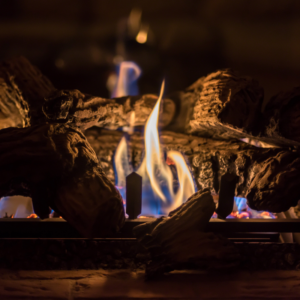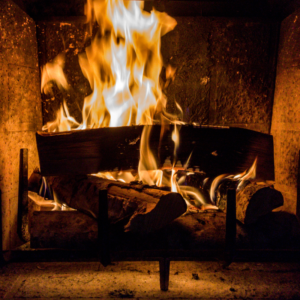A fireplace or stove is an efficient and attractive way to add heat to your home. If you have an existing fireplace, inserts can upgrade your look and efficiency and reduce emissions. Or maybe you want the flexibility offered by a freestanding stove. There are so many options!
Once you’ve made the exciting decision to enhance your home with a new or updated heating device, one of the first considerations is fuel type. Gas, wood, and electric options are available and each offers a range of features and benefits. Questions? We’re here to help.
While everyone wants to make the best choice, know that in the case of heat source, the decision is really which is best for you and your home. Thankfully, this means you can hardly go wrong if you’ve weighed the considerations with your own situation in mind.
All About Gas Systems
If you want a cozy fireplace, but don’t want to deal with ash, fumble with matches, or maintain a messy woodpile, gas might be the winning choice for you. Gas units ignite at the flip of a switch, which means when you get home at the end of a long day, you’re minutes away from slippers and a roaring blaze. And when you’re ready to call it a night, there’s no waiting for a fire to burn down or subsequent clean up.
Other perks of operating a gas unit?
 Gas units are famously efficient. While the stats will vary from unit to unit, inserts burn with over 90 percent efficiency, delivering lots of warmth and comfort into your living room.
Gas units are famously efficient. While the stats will vary from unit to unit, inserts burn with over 90 percent efficiency, delivering lots of warmth and comfort into your living room.- They’ve got a low carbon footprint. As far as environmental impact is concerned, you’ll be pleased at the strides all types of units have made in this department. But since gas appliances generate almost no smoke or particulate emissions, they tend to excel in terms of impact on air quality. No smoke also means no creosote to deal with, which is a big advantage.
- Temperature control is a breeze. Gas fireplaces offer you precision control over temperature settings and many other options that affect the aesthetics of your fireplace as well – both in terms of appearance and the types of flames it produces.
One thing to note before diving into this option, though. If you’re retrofitting a gas insert into your existing traditional fireplace or adding a new unit, this will require installation of a new gas line to the location – and you’ll have to pay for the supply of gas that you use. That said, the former is a one-time cost and the latter is still an economical way to heat your home.
The Facts on Wood-Burning Fireplaces
Ah, the sounds and smells of well-seasoned firewood crackling away when the world outside is snowy white – can anything beat it? It’s true that you’ll be hauling wood, building and feeding your fire, but for some this process is part of the charm of enjoying a fireplace. The ambiance and aesthetic of a wood-burning appliance radiates traditional comfort and cheer.
Other pros in addition to an unbeatable aesthetic?
 Firewood is pretty easy to get your hands on. It can be delivered ready to use, or, if you have access to firewood you can chop yourself, you have an extremely inexpensive way to heat your home right at the end of your ax.
Firewood is pretty easy to get your hands on. It can be delivered ready to use, or, if you have access to firewood you can chop yourself, you have an extremely inexpensive way to heat your home right at the end of your ax.- Newer wood units are engineered for efficiency. And their environmental-friendliness far outstrips older and open hearth models of the past. You can expect delightful radiant heat along with the ambient glow that warms your space.
And the downsides? If you choose a wood-burning unit, be prepared not only to build fires, but also to clean up after them. There’s soot and ash involved in burning wood, so you’ll need to regularly clear out the firebox and properly dispose of ash.
And, for gas and wood units alike, you’ll need your professional sweep to annually inspect and regularly clean your system.
Is an Electric Option Best for You?
No chimney? No desire for a construction project? No problem. You can still enjoy warmth and glow of a fireplace with an electric unit. Electric systems are affordable and require minimal commitment, no tearing into walls for installation, and the easy flexibility of being able to move the unit around to find the optimal spot.
And if you relocate to a new home? You don’t have to leave the fireplace you’ve come to love behind. Portability and convenience rank among an electric unit’s chief benefits.
Can I Burn Wood in My Gas Fireplace?
Since the appearance of gas and wood-burning systems is similar, it might seem you can use either fuel type in a gas unit. This is NOT the case. Attempting to burn real firewood in a gas unit is unsafe, as gas systems are not designed to vent the smoke and fumes burning wood produces out of your home. Also, the clearances and design are different, creating a fire risk if used improperly.
Long story short – wood burning appliances use wood and gas appliances host gas. Either type of unit is wonderful when used as intended. But using an improper fuel source can cause damage to your unit or home, smoke back-up, and fire hazards. Don’t risk it.
Which to Choose? We’re Here to Help
A gas, wood, or electric unit can all add value to your home. Consider how each would fit into your home and lifestyle, and you can be confident in your choice.
Do you have more questions, or have you settled on a specific type of unit and want to know which further options are available? We’re here to help you with professional, friendly service in each step of the process.
Let’s get started – call 513-727-0994 or reach out online today.
